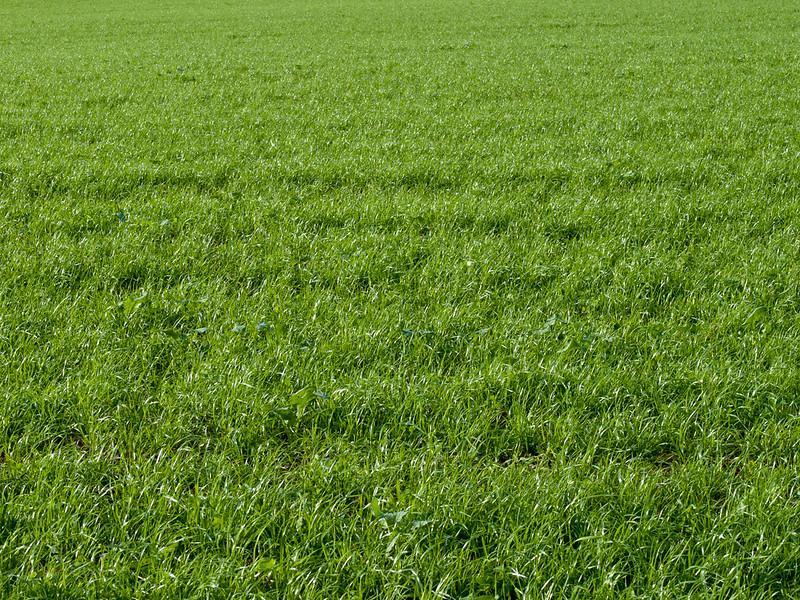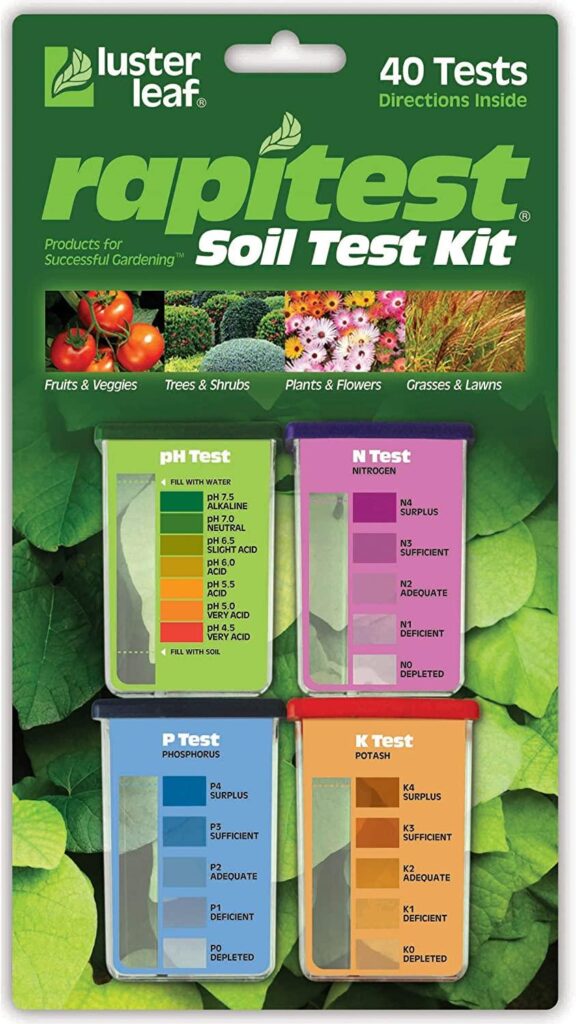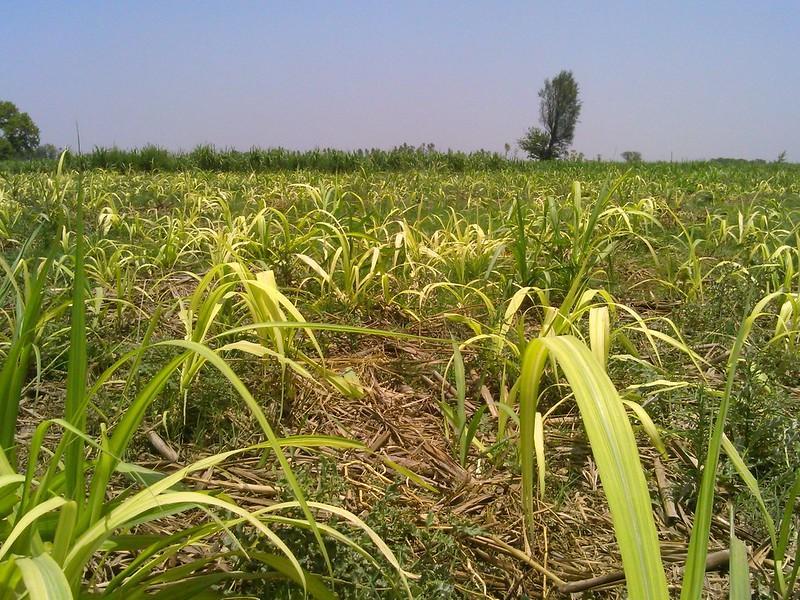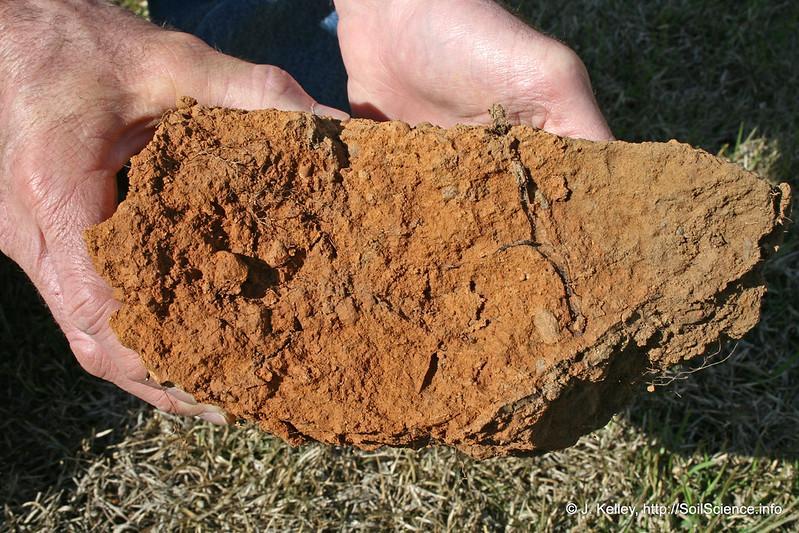If you have been watering your lawn regularly and it still has a spotted or patchy appearance, it is very much possible that your grass is suffering from nutrient deficiencies. Common deficiencies include iron and nitrogen, which both have very similar symptoms. Read on and find out about nitrogen vs iron for lawns.

Even though nitrogen can help a regular grass green up, it will not benefit an iron-deficient lawn.
Both iron chlorosis and a nitrogen deficit will cause the grass to turn yellow, which makes it simple to confuse the two conditions. In addition, each condition has its unique treatment, so it is essential to diagnose the issue at hand accurately.
Also, to determine what to use on your lawn and when to apply it, it is vital to have a solid understanding of the effects of nitrogen fertilizer and iron amendments on your grass. Thankfully, simple options exist for distinguishing between these various soil deficiencies.
In this article, I will compare the use of iron and nitrogen, describe how each product functions, and assist you in determining which product will benefit your lawn the most.
Nitrogen For Lawns

Nitrogen helps in the synthesis of proteins that grass cells require to grow.
When it comes to fertilizing a lawn, nitrogen is hands down the single most critical nutrient to use. Nitrogen assists grass in producing new, green foliage above the soil level. The plant subsequently uses this foliage to photosynthesize, which generates energy for continued root growth and disease prevention.
Without it, plants will turn yellow, show stunted growth, and in extreme cases, die. Therefore, if you discover areas of your lawn are yellow, withering, or covered in weeds, your lawn may be trying to tell you that it desperately needs nitrogen.
All in all, lawns love nitrogen; however, it is essential to establish a balance between vigorous leaf growth and robust roots capable of maintaining it. For instance, if there is an insufficient supply of nitrogen, grass will not create enough chlorophyll. However, if you use too much nitrogen, grass will suffer from poor root development.
Signs Of Nitrogen Deficiency

Lawns with insufficient nitrogen may seem pale and spotty and develop poorly overall.
In turfgrass, the lack of nitrogen is by far the most frequently seen nutritional shortage. It inhibits the production of chlorophyll, the compound that gives grass its green color. So, when turfgrass lacks nitrogen, it turns yellow and has less vigor than usual.
The yellowing that occurs as a result of nitrogen deficiency, in most cases, tends to be more widespread throughout the grass than appearing in patches like iron deficiency does. Therefore, checking to see which part of the plant is turning yellow is another way that can be used to tell whether the grass is suffering from a lack of nitrogen or iron.
In case there is insufficient nitrogen, you will observe issues with the lower portion of the grass blades. In other words, older grass blades will first turn yellow without nitrogen.
Additional symptoms of nitrogen deficiency may include the following:
- Your grass has recurring disease issues.
- It is taking longer for the grass to grow.
- Grass having trouble recovering from foot traffic and environmental changes.
Testing For Nitrogen Deficiency

Luster Leaf 1601 Rapitest Test Kit for Nitrogen, Phosphorus, Soil pH, and Potash.
A number of telltale symptoms can recognize nitrogen deficiency. However, those symptoms alone cannot serve as a diagnosis. It is fortunately not difficult to determine whether or not your soil has a nitrogen deficiency.
There are a number of different soil tests that can be purchased in stores that will disclose the amount of nitrogen in your soil. Simply follow the instructions on your soil test to determine if your soil is nitrogen deficient.
However, if you do not have a soil testing kit, do not worry; there is another way! Simply test a small area by fertilizing it with a small amount of nitrogen and observe what happens. For this purpose, fertilizers like calcium nitrate and ammonium sulfate can be applied.
If the grass starts growing normally again, you know the problem is a lack of nitrogen, and you should go ahead and get more nitrogen fertilizer.
RELATED: How and When To Use Ironite In A Lawn For Best Results?
Fixing Soil Nitrogen Deficiency
When you are sure that your grass or lawn is suffering from a nitrogen deficiency, you will need to amend your soil and add additional nitrogen. Organic approaches take considerable time, but the results will be more uniformly dispersed over time.
You can also use non-organic compounds to fertilize your lawn. You can also use non-organic fertilizers to fix the issue; however, if you add too much of these to your garden, there is a high likelihood that you will accidentally burn your grass.
Nevertheless, here are a few ways to fix nitrogen deficiency in the soil.
Add Manure To The Soil

Home gardens benefit significantly from the addition of animal manure to their soil.
Animal excrement contains a significant amount of nitrogen; this concentration is so high that, in most cases, adding animal excrement directly to the soil will cause the grass to burn. Nevertheless, since it takes time for manure to break down and find its way into the soil, this is not the method to use if you want the nutrients to be instantly available. Despite this, the method yields the best results since its effects are prolonged on the ground.
Add Coffee Grounds To The Soil

Coffee grounds can be used as fertilizer since they enrich the soil with organic matter.
Do you enjoy drinking coffee? Or you might have a buddy who works in a coffee shop; ask them if they can save you some of their spent grounds. The spent grinds from coffee are an excellent source of nitrogen. Put them in your compost pile or directly mix the grounds with your soil. Although it takes some time for them to decompose and release their nutrients into the soil, they help aerate the soil and promote drainage.
Plant Nitrogen Fixing Plants

Most agriculturally important legumes are also excellent nitrogen-fixing plants.
There are some plants that are known as nitrogen-fixing plants, which implies that as they grow, they will add nitrogen to the soil. Beans and legumes are the two primary ones that you should add to your garden beds. So, consider growing beans and legumes in areas where you previously produced nitrogen-hungry grass.
Also, remember that you should reduce the amount of fertilizer you apply to the garden beds or places where you planted bean crops the year before or altogether avoid doing so. You could wind up with an excess of nitrogen in the soil.
RELATED: Why and When Should You Add Iron To Your Lawn For The Best Results
Iron For Lawns

Iron can help your grass achieve a healthier and more vibrant green color.
If you’ve ever admired an emerald-green lawn and wondered how it got that green, it was most likely fertilized with iron. Using iron can help your grass achieve a healthier and more vibrant green color. It is conceivable that your soil does not have enough iron if you have seen that your grass is a lighter shade of green or even if it is beginning to take on a yellowish hue.
To maintain its vibrant green color and robust health, the grass in your yard requires an iron supplement. In addition, your lawn soil will have a more basic pH if there is insufficient iron in the soil, making it more difficult for grass and other plants to take root.
In the absence of sufficient iron, the grass on a lawn might begin to turn yellow and eventually perish. This condition is known as iron chlorosis. When iron chlorosis is extremely severe, the already yellow grass blades will turn to a yellow color.
Signs Of Iron Deficiency

The youngest, most recent leaves show the earliest signs of iron insufficiency.
Your grass will look yellow and spotted if it is suffering from a lack of iron, which will cause the grass to turn brown. You should also note that in case of iron deficiency, the veins of the leaves will be rather dark, with pale yellow crevices between them.
As the severity of the deficiency increases, the veins on the leaves will begin to turn a lighter color, and brown spots will emerge on the leaves. These brown blotches are going to spread, which will result in the death of the leaves. A light green tint on the top of your grass blades is usually the first indicator of an iron shortage.
The lowest levels of the grass are most likely going to be darker. This happens in the younger leaves first since iron is not a mobile element in the plant. Therefore, iron can’t be absorbed by the younger leaves from the older leaves.
After some time has passed, the yellowing may even turn a very faint white. Usually, the signs and symptoms of iron deficiency grow more noticeable over time.
Testing For Iron Deficiency

Iron deficiency starts with a yellowing of the leaves in between the dark green veins.
Iron deficiency, much like nitrogen deficiency, can be recognized by several telltale symptoms; however, the symptoms themselves are insufficient to serve as a diagnosis. Luckily, finding out whether your soil suffers from an iron deficit is a relatively straightforward process. The only thing you need to do is take a soil sample to a nearby laboratory, and they will gladly perform an analysis on the sample for you.
A tissue examination of leaves is another technique to determine whether or not a plant has an iron deficiency. This method can be used in addition to a soil test. Tissue analysis is used to provide an accurate reading of the amount of iron found in the plant. Plants that are not iron deficient will have an iron level in their dry matter greater than 50 ppm.
RELATED: Ironite Vs Milorganite: What’s The Difference and Which Is Better?
Fixing Nitrogen Deficiency
It is extremely rare for a deficiency of iron in the soil to be the source of an iron deficiency in plants. Iron is usually present in large quantities in the soil. However, the ability of a plant to access the iron in the soil can be hindered by a wide variety of environmental conditions. In most cases, one of these four factors is the cause of iron chlorosis in plants.
- Phosphorus levels in the soil are too high.
- Soil that is either too compacted or too wet.
- Clay content in the soil is high.
- The pH of the soil is too high.
Let’s discuss each of them one by one.

In lawns, gardens, and pastures, an excess of phosphorus can stunt or even kill plants.
An excess of phosphorus can prevent the plant from absorbing iron, which can result in chlorosis of the leaves. In most cases, the disease is caused by using a fertilizer containing excessive phosphorus. To restore equilibrium to the soil, use a fertilizer with a percentage of phosphorus (the middle number) lower than normal.
Decrease Soil Compaction

Compacted soils often are the reason behind iron deficiency in plants.
If your soil is excessively compacted or too damp, the roots will not be able to absorb enough iron for the plant. Iron deficiency and chlorosis are both made worse by chilly soil temperatures and situations that impede air movement into the soil. You will have to work to enhance the drainage of the soil if the soil is excessively damp.
If you cannot improve the drainage or reverse the compaction in your yard, lawn, or garden, you can apply chelated iron as a foliar spray or as a soil supplement.
This will enhance the iron content accessible to the plant and compensate for its diminished ability to absorb iron through its roots.
Reducing Clay Content In Soil

Clay soils are poor in organic matter, which often leads to iron deficiency.
Organic matter typically contains trace elements, such as iron, that a plant requires to be able to absorb iron into its roots. Clay soil is actually unable to supply a plant with the necessary iron because it does not contain any organic material.
Adding organic material to the soil, such as peat moss and compost, is one way to treat iron deficiency in plants when the problem is caused by clay soil.
Fix Soil pH

Soil’s high alkalinity is also a reason why your plants might be suffering from iron deficiency.
Most plants will not have iron deficits in soils with a pH less than 6; however, some plants will become iron deficient at a pH less than 6, while others will not become deficient until the pH approaches 7. Your local extension office should be able to test your soil for you. When the soil pH exceeds 7, the plant’s capacity to absorb iron from the soil is impeded.
Do Not Guess, Test The Soil!
I believe that testing your soil on an annual basis in the spring is the best way to gain a thorough grasp of what your lawn already has and what it requires. By doing so, you will be able to save money while also achieving better results.
You won’t have to enter the season speculating about what your grass requires; instead, you’ll know exactly how to maximize the potential of your lawn.
Final Thoughts
To provide your lawn with the necessary care, homeowners must analyze and troubleshoot lawns with precise data from a soil test. The yellowing you observe on your grass may have several causes, two of which are nitrogen and iron deficiencies.
When it comes to lawns, you don’t have to choose between iron and nitrogen because your lawn will probably benefit from both. If, however, you can grasp the effects nitrogen and iron have on your yard, you will be able to better care for your grass.
Frequently Asked Questions (FAQs)
What fertilizer has nitrogen and iron?
Milorganite is a fertilizer manufactured from reclaimed wastewater. It includes 2.5% iron by weight. However, in addition to providing iron, it also gives them nitrogen, which is one of the “big three” nutrients that plants require. Aside from that, Lawn Energizer is a high-quality liquid Iron booster that has been enhanced with nitrogen.
Is iron fertilizer good for lawns?
Iron contributes to the vigor of your grass and the enhancement of leaf color, making your lawn greener. However, problems with iron and nitrogen both result in the dull, yellow, or light green tint of lawn grass. Therefore, your soil must have enough of these two nutrients.
Can you apply iron and nitrogen at the same time?
It is possible to fertilize your lawn with both iron and nitrogen at the same time. However, before you go ahead and do so, you should have the soil tested. It is imperative that you do this so that you do not accidentally introduce an excessive amount of any nutrient into the soil, which might be detrimental to the plants.
When should I apply iron to my lawn?
You can apply iron to your grass at any time of year. However, the best time to apply iron to your grass is in the springtime, when temperatures range from 60 to 70 degrees Fahrenheit. It is best to refrain from using iron when the weather is hot.
Can I put too much nitrogen on my lawn?
Nitrogen is one of the elements necessary for a healthy lawn, but having an excessive amount of nitrogen can lead to various issues. For example, an overabundance of nitrogen, which an excessive fertilizer application can bring about, can lead to rapid and lush growth while simultaneously shrinking the size of the root system.
Sources For Further Reading
Nitrogen and Iron Deficiencies – University of Arizona – Community IPM
Turfgrass Fertilization: A Basic Guide for Professional Turfgrass Managers – The Pennsylvania State University Extension System
Choosing Fertilizers for Home Lawns – University of Illinois Extension Service
Editor’s Recommendations
How To Identify and Control Black Medic Weed In A Lawn | A Comprehensive Guide
Lawn Edging Techniques For A Professional Finish | A Comprehensive Guide
Lawn Mower Height Settings | What’s The Best Mowing Height For Lawn Grass?







